
1. What is the nature of light?
2. What are some important structures of the eye?
3. How are rods and cones different?
4. What is some evidence for duplex and duplicity theory?
5. What factors affect visual acuity?
6. What factors affect brightness perception?
7. How is neural information processed in the retina?
8. What is a receptive field?
9. How does lateral inhibition explain some lightness illusions?
10. What is some evidence that the visual system detects spatial frequencies?
• Isaac Newton (1704): light acts like a ________
• James Clerk Maxwell (1873): light has ________ properties (produces diffraction patterns)
• light is electromagnetic radiation (like gamma rays, radio, radar, etc.)
• visible from ~380 to ~760 nm (billionths of a metre)
• the eye __________ light energy → neural impulses
Ḥasan Ibn al-Haytham (b.c.965-d.c.1040)
- called the “father of optics” and a “pioneer of modern optics”
- wrote Book of Optics (1011-1021):
• vision produced by light reflecting from surfaces into the eye
• visual perception occurs in the brain
• perception is __________ and affected by individual experience
- laid the foundation for the __________ method
• light first strikes ______: concentrates light rays
• passes through aqueous humour
• passes through _____ (hole in centre of the iris)
- pupil dilates (gets larger) in the dark to let in more light
- contracts in bright light to protect the eye
- sunglasses should have UV protection to guard against retinal and corneal damage
e.g., iggak (caribou antler goggles) worn by the Inuit protect against snow blindness (_________ corneas)
• passes through crystalline lens
- _____________: ciliary muscles change shape of the lens, altering its focal length, which keeps image focused on retina

![]() [original]
[original]
- elasticity reduces with age, making ____ point (minimum distance at which you can focus) move farther away: presbyopia
• passes through vitreous humour to retina
• receptors (____ and _____) point to the back of the eye
• synapse with bipolar cells (have two long extensions)
• which connect to ________ cells (2 types): P-cells and M-cells
• horizontal cells: make lateral connections among receptors and bipolar cells
• amacrine cells: laterally connect among bipolar and ganglion cells
• ______ retina theory (Schultze, 1866):
- observed that retinas of nocturnal animals (e.g., owls) only contained rods
- diurnal animals (e.g., pigeons) only contained cones
- animals active during day and night had both rods and cones
• _________ theory (von Kries, 1896):
- related rods and cones to scotopic (dark) and photopic (light) vision
rods |
cones |
|
number: |
~120-125 M |
~5-6 M |
location: |
_________ only |
fovea & periphery |
sensitivity: |
high |
low |
vision: |
scotopic |
photopic |
characteristics: |
black & white |
______ |
• _____ centralis: used for directed looking
- densest concentration of receptors in the eye
- only has cones (peripheral retina contains rods & cones)
Functional differences between rods and cones: ____ adaptation
- ambient illumination changed from light to dark
- after a while, eyes adapt: sensitivity increases
Expt. 1: dark adaptation curve
- procedure: room lights go out; test light shined in observer’s _________ (rods & cones)
- test light adjusted to absolute threshold repeatedly as time passes
- result: threshold decreases (sensitivity increases) with time
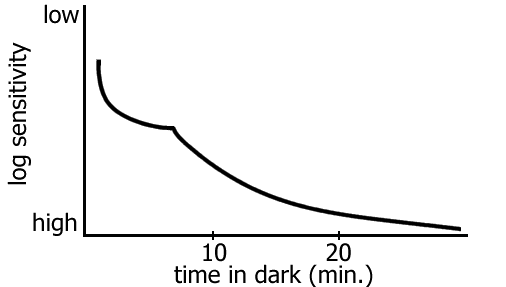
Expt. 2: cone adaptation
- repeat expt.1, but shine test light on _____
- result: explains part of the curve
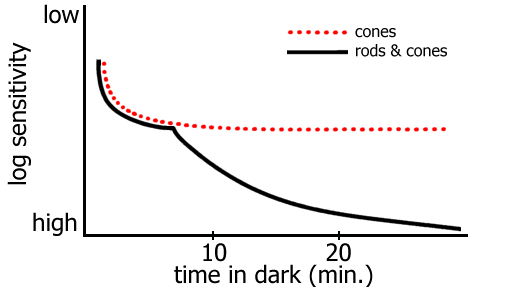
Expt. 3: rod adaptation
- problem: how do you measure rods alone?
- solution: rod ____________, due to a genetic defect, have only rods on their retinas (in the periphery)
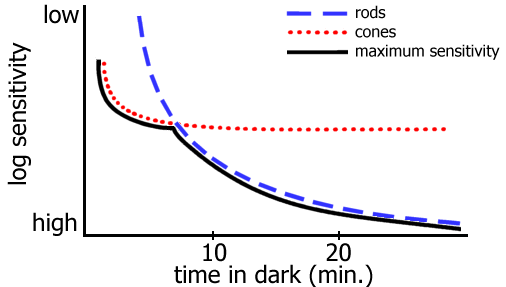
What causes this difference?
- different pigments in rods and cones
- Boll (1876) found photosensitive pigment in rods: bleached in the light and regenerated in the dark
- _________ comprised of retinal and opsin
- when hit by light, retinal changes shape (_____________), causing a chain of events that culminates in a neural signal
- __________ spectrum: amount of each wavelength absorbed by each type of pigment
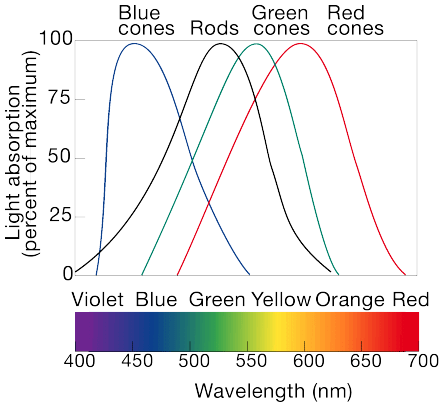
Hecht, Shlaer, & Pirenne (1942): measured absolute threshold
- observers detected a flash of light of 100 photons
- 50 reached retina (rest bounced out/absorbed)
- only 7 photons absorbed by pigment molecules
- but...flash distributed over an area with 500 receptors
- likely that each photon hit a different receptor
- thus, ___ photon is the minimum to change the shape of a pigment molecule
Rushton (1961): measured pigment regeneration using retinal ____________
- shone thin, dim beam of light onto the retina
- some bounces off the back of the eye and is reflected out
- receptor pigment absorbs light--until it bleaches out, causing more light to be reflected out
- measured amount of reflected light over time: indicates time for pigment to regenerate
- result: cones take 6 min., rods take 30 min.
- pigment is re-formed, with the help of (beta ________ →) vitamin A + enzymes
Measurement:
• _______ chart (1862) measures foveal acuity only
- normal is 20/20 vision (what you can see at 20 feet vs. distance for normal person to see)
- 20/200 (or worse) is legally blind
- what is the unit of measurement?
• optometrists use ________: reciprocal of focal length (m) of corrective lens
- negative = concave lens (for nearsightedness)
- positive = convex lens (for farsightedness)
• visual _____: size of retinal image in degrees

tan (α) = size ÷ distance = 2.4 cm ÷ 70 cm = 0.034, therefore α ≈ 2°
- note: 1° = 60' (minutes of arc), and 1' = 60" (seconds of arc)
- with 20/20 vision, details of 1' can be resolved (size of a quarter at the distance of a football field)
Factors affecting acuity:
• ___________: resolution of details of 10" or less of vernier gratings (exceeds resolution of receptors):
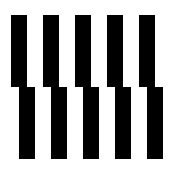
- cone spacing in fovea = 12" (1 μm)
- expected resolution = 24" (theoretical limit)
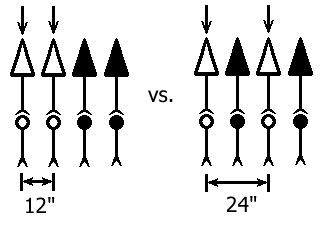
- hyperacuity may be due to complex neural processing in the visual cortex (Wilson, 1986)
• retinal locus: fovea has greatest acuity
- high (cone) receptor density
- low spatial _________ (convergence of a number of receptors to a single neuron)
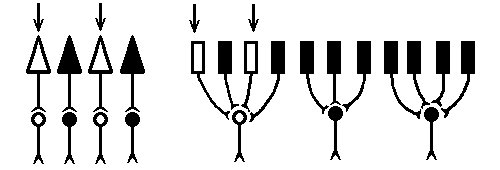
- cortical _____________ factor: gives millimetres of cortex per degree of visual angle, as a function of retinal eccentricity
M = (1 + 0.36E + 0.000048E3)-1 M0 |
M0 = foveal cortical magnification factor |
E = eccentricity |
(proportionally more cortex is devoted to the retina than to the periphery)
• focusing errors:
- ______: image focused in middle of the eyeball (nearsightedness)
- hyperopia: image focused behind retina (farsightedness)
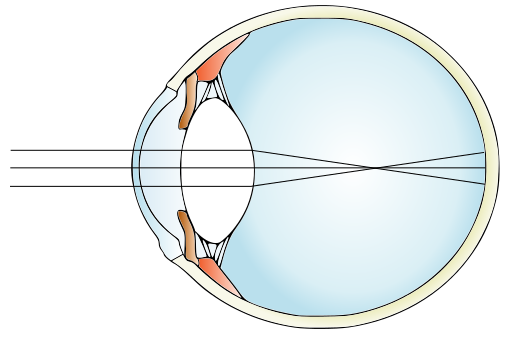 |
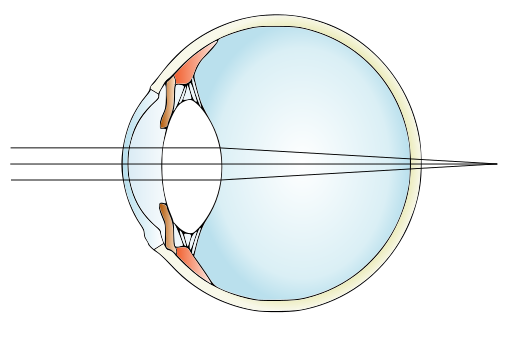 |
|
|
- ___________: cornea is not spherical, but asymmetrically curved (like a football), causing multiple focal points

• _________ aberration: different wavelengths focus at different points:
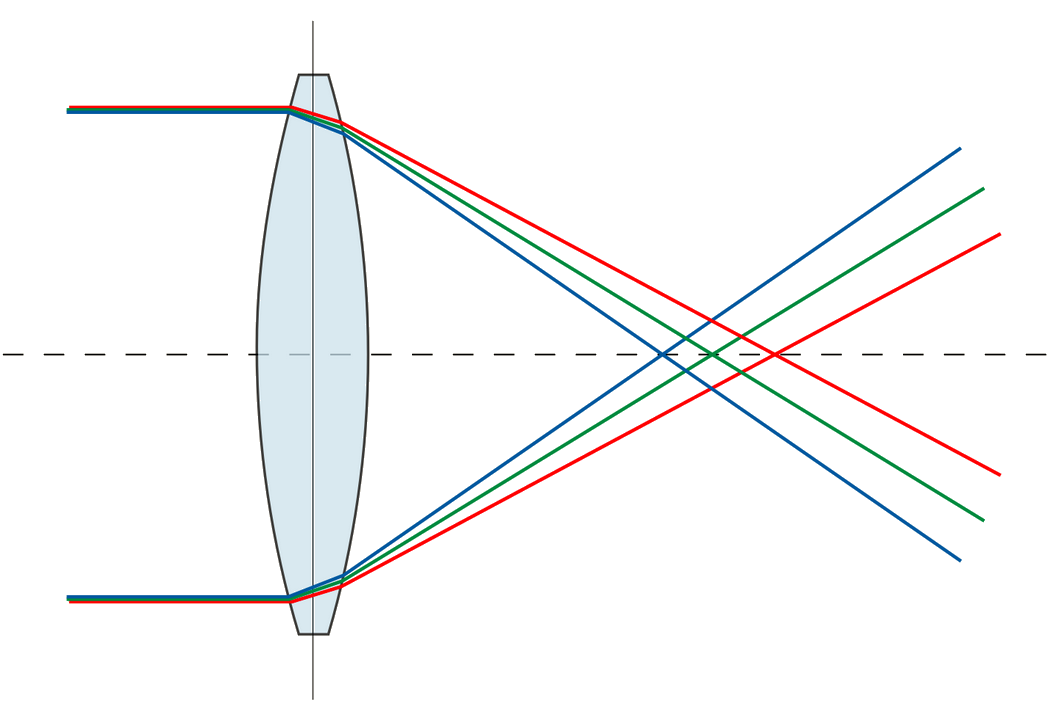 |
|
• _________ aberration: light rays focus at different points depending on how far from centre they pass through a lens:
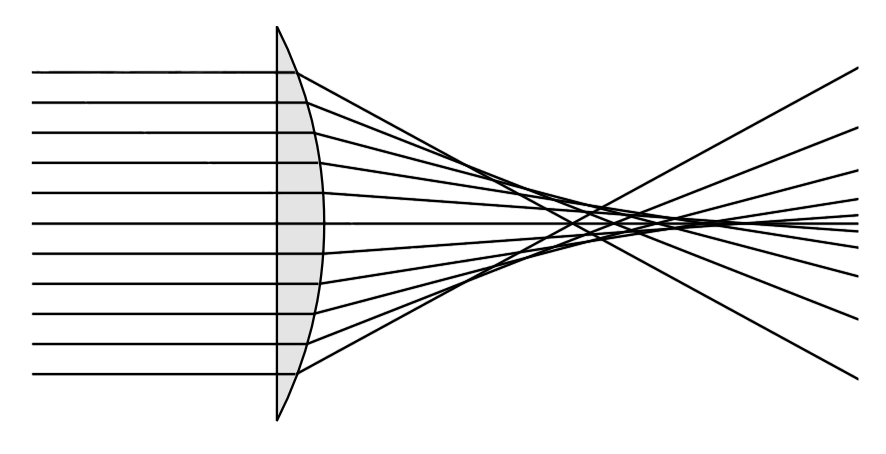
- smaller pupil minimizes this
• ___________: light waves bend around obstacles in their path or through a slit; affects different wavelengths to different extents
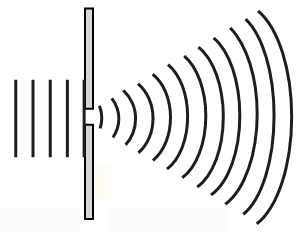
- larger pupil minimizes this
- optimum pupil trade-off size = 2.4 mm
Application: how far should I sit from an HDTV?
• main issue used to be a trade-off: too close and you see each pixel; too far and you’ve paid for resolution you can’t see
• however, Ultra HDTV (4K or 8K) probably exceeds human visual ______
• current debate centres on field of ____: the amount of visual angle presented by a display
• Society of Motion Picture & Television Engineers recommends that a screen should fill 30 to 40° of your field of view for an immersive experience
- formula: size of screen × 1.6264 = distance for 30° field of view
e.g., a 55-inch screen × 1.6264 = 7.5 feet
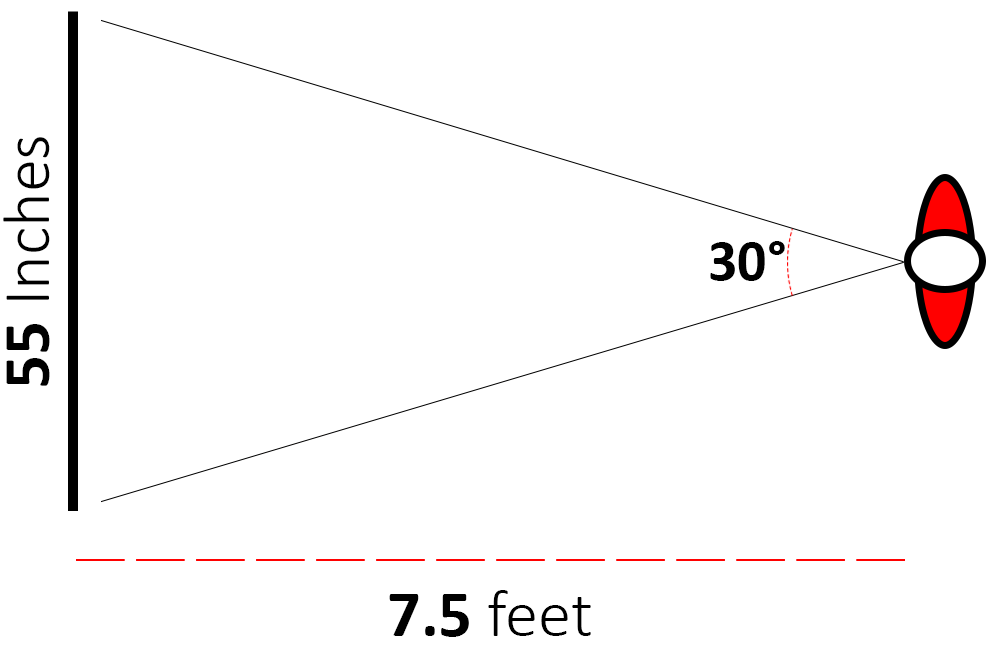
• Joor et al. (2009): top-down processing
- one group told they were watching HDTV clip
- other group told they were watching digital DVD clip
- HDTV group reported sharper, more detailed images
- but both groups watched the ____ (low) quality DVD clip
- shows the cognitive bias of the _______ effect: top-down processing can influence even basic visual perception
• Langer et al. (2010): led observers to believe that certain things improve visual ______
- being a pilot, then flying in a realistic flight simulator: 42% improved
- practice, then doing eye exercises: 18% improved
- motivation: 10% improved
- physical fitness, then doing jumping jacks: 38% improved
- reversing a Snellen chart so that you start with the smallest letters
Photometric units (photometry: measurement of light):
• ________: radiant power from a light source
- unit: lumen = light produced by a standard candle (“candela”)
e.g., 1 lm = 1.46 mW
• ___________: amount of light falling on a surface
- unit: lux = 1 lumen per square metre of area (lm/m2)
e.g., daylight = 10,000 lux, full moon = 0.1 lux
• _________: amount of light reflected from a surface
- unit: nit = 1 candela per square metre of area (cd/m2)
e.g., LED monitor = 250 nits, iPhone = 1,000 nits
• ___________: proportion of light reflected from a surface
- unit: percent (%) or “albedo” = (luminance/illuminance) × 100
e.g., white paper = 90%, black paper = 10%
• __________: perceptual impression of intensity of light source; psychological counterpart to radiance
• _________: perceptual impression of surface “greyness”; psychological counterpart to reflectance
Factors in brightness perception:
• dark/light adaptation
• retinal _____: threshold lower in the periphery (due to greater rod convergence/summation):
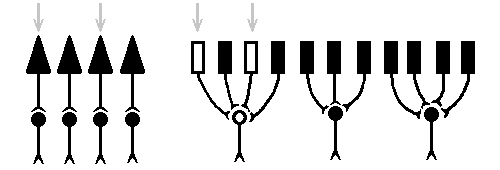
• __________:
- match standard colour with comparisons based on brightness; get absorption spectrum
- repeat under different illuminations (photopic vs. scotopic)
- during dark adaptation, we shift from using cones to rods
- result is ________ shift (1825): peak sensitivity changes to shorter (bluer) wavelengths
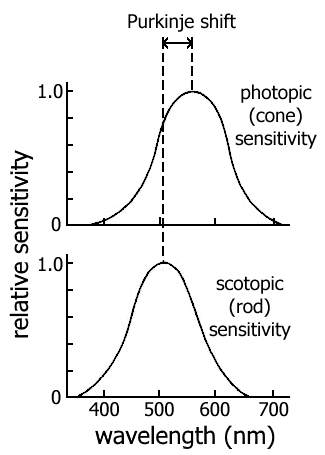
• time and area: brightness affected by duration and retinal size of stimulus
• _____ nerve: axons of retinal ganglion cells
- exits back of the eye where there are no receptors (optic disc), producing the physiological _____ ____: about 7.5° in height and 5.5° in width
- retina begins processing visual information: ~126 million receptors; but only 1 million nerve fibres
• _________ _____: area on the retina that, in response to a stimulus, influences the firing of a neuron
- typical (ganglion cell) receptive field is centre-surround:
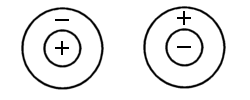 |
||
excitatory-centre- inhibitory-surround |
inhibitory-center- excitatory-surround |
|
- this formation is due to a pattern of connectivity between many receptors and a single ganglion cell
• _______ __________: some cells, when activated (e.g., by the presence of a stimulus), decrease the activity of adjacent cells
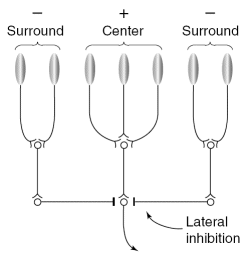
- due to the release of inhibitory neurotransmitter
Chevreul illusion (1861): each band is uniform shade of grey, but seems to darken near a lighter band, and lighten near a darker band
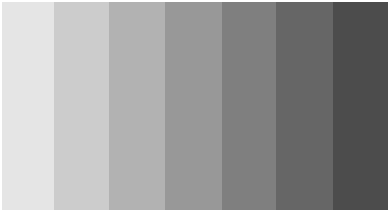
- adjacent receptors believed to inhibit neighbouring receptors
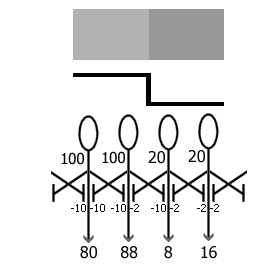
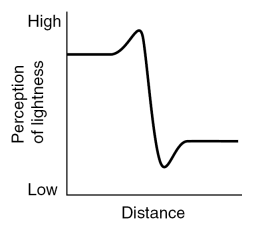
- difference in luminance at border exaggerated by _______ __________
Simultaneous contrast: central squares appear different shades
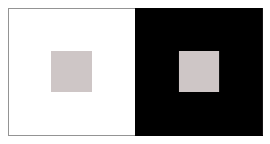
- explained by lateral inhibition: receptors activated by larger surrounding square inhibit receptors in smaller central square
Benary cross (1924):
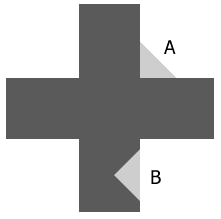
- both triangles should receive ____ lateral inhibition, but seem different shades
White’s illusion (1979):
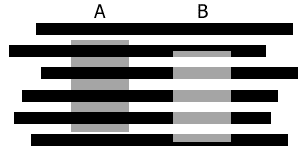
- rectangle A should receive little lateral inhibition (and seem _______), but it seems darker
- rectangle B should receive a lot of lateral inhibition (and seem ______), but it seems lighter
- explained in terms of “_____________”: appearance of an areas is influenced by the surroundings to which it seems to belong (Gilchrist et al., 1999)
- triangle B belongs to the dark cross, which makes it seem lighter in contrast
- rectangle B belongs to the black bars, which makes it seem lighter in contrast
- suggests ______-_____ processing instead of retinal mechanism
(Blakemore & Campbell, 1969; Shapley & Lennie, 1985)
How does the visual system process spatial information?
• spatial frequency: how a stimulus changes over space (cycles per degree of visual angle)
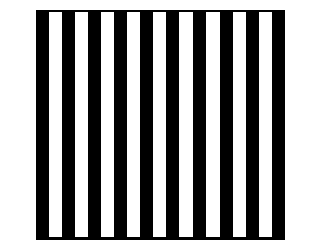
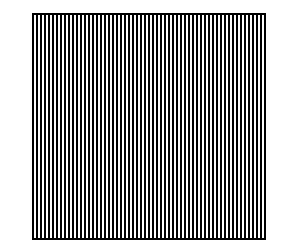
- one cycle = one dark bar + one light bar:
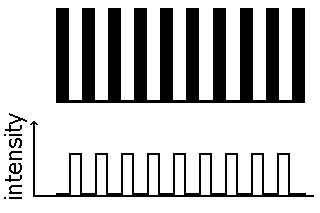
- higher intensity regions produce peaks, lower intensity areas correspond to troughs
_______ analysis:
- simplified scene description in terms of a set of sine waves
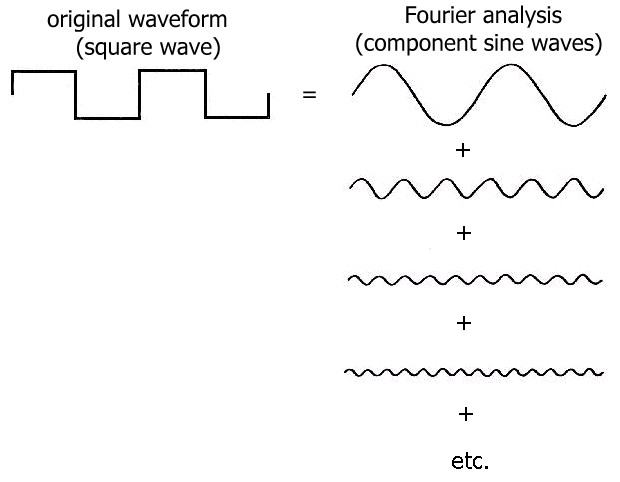
- result: mathematical expression describing the visual scene in terms of sine waves:
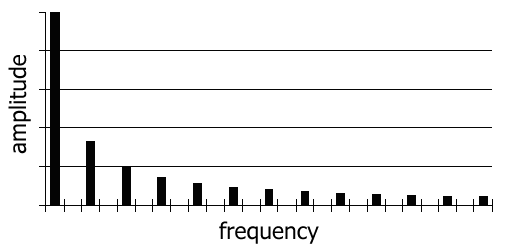
- better than taking inventory of the activity of all ~126 million receptors!
- allows us to investigate commonalities in the processing of visual information
________ ___________ function: describes ability of a system to preserve contrast and spatial frequency information after it has been encoded
e.g., a spatial frequency of 100,000 black & white lines/degree of visual angle cannot be encoded by the visual system; perceived as a uniform grey field
- ________ ratio = (Lmax - Lmin) / (Lmax + Lmin)
• based on physical measures of light (L = luminance)
• however, apparent contrast is affected by spatial frequency:
e.g., wide black bars appear darker than narrower bars; wide white bars appear lighter than narrower bars
Creating CSF:
1. present observer with a grating of black & white bars of a certain spatial frequency
2. change contrast between the black and white bars until observer no longer perceives stimulus as lines
3. change spatial frequency and repeat:
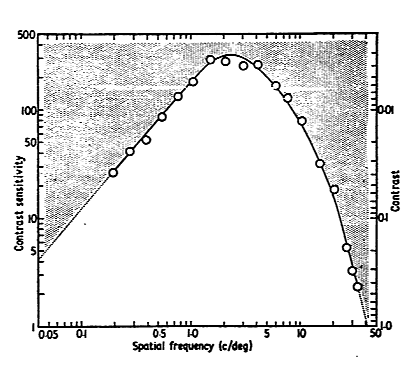
- describes contrast sensitivity and acuity
Is this a monolithic function, or comprised of “________”?
1. adapt to a spatial frequency of 7.5 cycles/degree
2. remeasure the contrast sensitivity function:
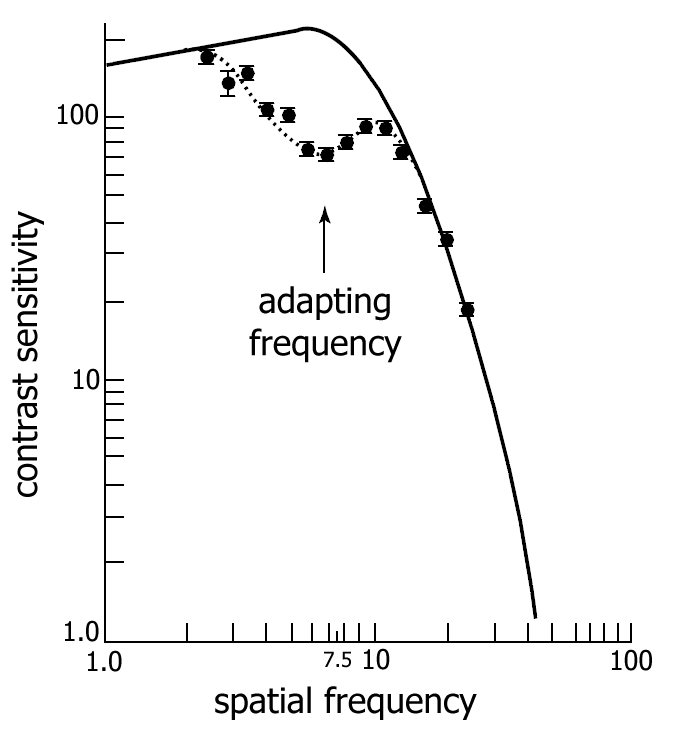
- suggests contrast sensitivity function is comprised of a series of spatial frequency channels (De Valois & De Valois, 1990):
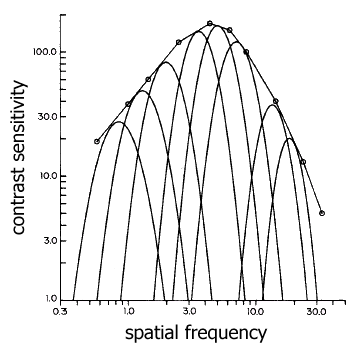
Maffei & Fiorentini (1973):
- each ______ cell responds best to a narrow range of spatial frequencies:
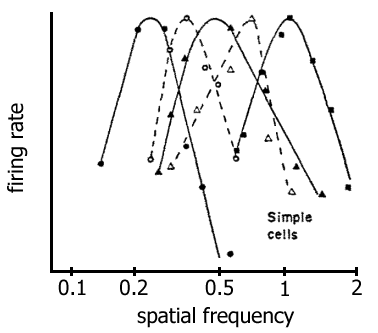
- adaptation effects are caused by neural fatigue
A given centre-surround receptive field of a certain size can detect only a grating stimulus that has a specific matching size:
• grating too big:
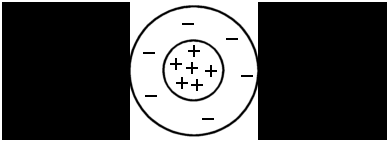
• grating too small:
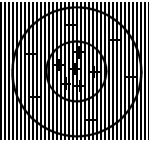
• grating just right:

Summary:
• different spatial frequencies in a visual scene are initially processed by cells with centre-surround receptive fields
• these act like “_______” to detect contrast between light and dark regions that exists at different scales, from fine details to coarse features
• further processing is done by the cortex to analyze _____, which are the basic components of visual stimuli
• spatial frequency analysis can be used to describe a visual stimulus, but it can also be used to explain how the visual system begins processing that stimulus